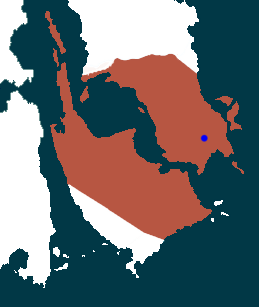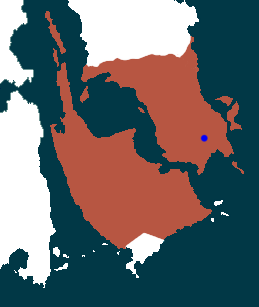Imperial State of Carinansia
Imperial State of Carinansia Estado Imperial de Cárinansia | |||||||||
|---|---|---|---|---|---|---|---|---|---|
| 1827–1965 | |||||||||
Motto: Dios, Patria, Rei | |||||||||
Anthem: Cárinansia Suprema | |||||||||
 Map of Carinansia in 1827 | |||||||||
 Map of Carinansia in 1965 | |||||||||
| Capital | São Alberto | ||||||||
| Official languages | Classical Spanic (1827-1857, 1943-1962) | ||||||||
| Common languages |
| ||||||||
| Religion |
| ||||||||
| Demonym(s) | Cárinansian | ||||||||
| Government |
| ||||||||
| Emperor | |||||||||
• 1827-1841 | Alberto I | ||||||||
• 1841-1857 | Alberto II | ||||||||
• 1857-1899 | Alberto III | ||||||||
• 1899-1939 | Alberto IV | ||||||||
• 1939-1965 | Alberto V | ||||||||
| Prime Minister | |||||||||
• 1908-1913 | Matías Sarmiento | ||||||||
• 1919-1920 | Lord Rolando Arboleda | ||||||||
• 1920-1932 | Franco Manzanedo | ||||||||
• 1932-1936 | Gonzalo Tejedor | ||||||||
• 1936-1941 | Juan Hurtado | ||||||||
| Legislature | Imperial Congress | ||||||||
| Imperial Senate | |||||||||
| House of Deputies | |||||||||
| Historical era | 1827 - 1965 | ||||||||
• Established | 16 June 1827 | ||||||||
• Arcadian Invasion of Lekeadia | 1842-1843 | ||||||||
• Promulgation of the People’s Constitution | 9 August 1908 | ||||||||
• The Distopia | 1945-1965 | ||||||||
• Disestablished | 14 June 1965 | ||||||||
| Population | |||||||||
• 1835 | 7,400,000 | ||||||||
• 1875 | 27,800,000 | ||||||||
• 1905 | 44,200,000 | ||||||||
• 1935 | 51,900,000 | ||||||||
• 1965 | 55,400,000 | ||||||||
| Currency | Imperial Peso | ||||||||
| |||||||||
| Today part of | Carinansia | ||||||||
| |||||||||
The Imperial State of Cárinansia was a state existing between 1827 and 1965, that comprised of southern Askihuac, and most of Lekeadia. Its government was an absolute monarchy under the rule of Emperor Alberto I, his son Alberto II, and his great-great grandson Alberto V, and a representative parliamentary constitutional monarchy under the rule of Emperor Alberto III, and his son Alberto IV. A centuries-old colony of the Arcadian Empire, tensions between the central government and descendants of colonists had risen over the previous years, as protectionist measures were imposed to defend the Arcadian economy. After waging a war for independence between 1814 and 1827, Viscount Sextus Voteporix Gaius, a direct descendant of Emperor Remus Caesar Augustus declared himself Emperor Alberto I on June 16, 1827. This officially marked the beginning of an independent Carinansian state.
Unlike most of the neighboring Arcadian Oikoian states, Carinansia had political stability, vibrant economic growth, respect for civil rights of its subjects. Slavery was abolished in 1835, although it was later reinstated in 1945. The Empire's unicameral parliament was initially appointed by the Emperor, but following political reform under subsequent rulers, it was elected under comparatively democratic methods for the era, as were the provincial and local legislatures.